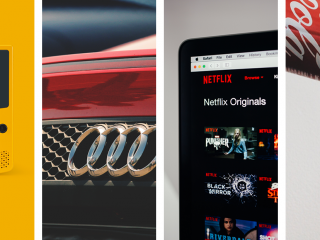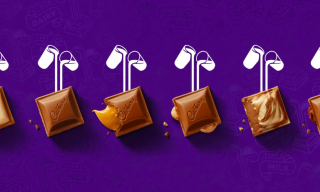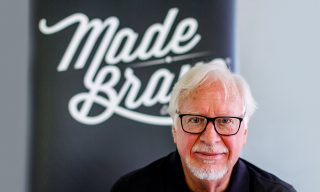A good brand is an agile one, here’s four brands that have moved and changed with the times.
Maybe we’re more exposed to it with what feels like a social media explosion going off anytime it happens, but rebranding seems to be happening a lot more today than it did in previous decades – and for good reason too. Even in the past few months alone, we’ve seen quite a list of giant rebrands, including Slack and Zara shaking things up and revealing an entire new look and feel to what we’ve seen from them before.
For some it’s more like a wardrobe review than a full head-to-toe overhaul, but it’s these subtle (or big) changes that really help to keep a business relevant in this ever-changing world of branding that we call home. It means making the effort to keep loyal audiences engaged and grab the attention of some newbies too.
So, how do brands go about making these changes without shifting into something completely unrecognisable? First up, it’s starts with knowing your brand inside out, and that means taking time to create your brand foundations and guidelines, which are essentially guiding principles for communicating your brand through everything it says, does and represents. By creating these guidelines and putting them into practice over a period of time, businesses are be able to see how their audiences react to their brand and in turn, make better, more informed decisions about their next move. Even though brand foundations and guidelines are designed to encourage consistency, they should be used as a springboard for new ideas, instead of a branding ball and chain (that’s why they’re called ‘guidelines’ instead of ‘rules that should never be broken, ever’). And that right there is why brands (like the four below) have managed to move and flow with the times.
A single mission by Nintendo

Even though they’ve existed as a brand since 1889, around a century before the computer gaming industry was ever established, Nintendo is a gaming company. This alone talks of the company’s resilience and ability to morph into existing technology markets and even create them.
Nintendo have survived. The Japanese translation of ‘nintendo’ aptly means to ‘leave luck to heaven’, and they certainly have carved their own path, most times in the opposite direction from others on a similar journey. The GAME OVER screen came a lot quicker to consoles from the likes of Sega, NeoGeo, Atari, Omega and many others who dropped-off (but don’t worry, they’re still around with awesome software, so it’s good).
Nintendo exists and survives because they take massive risks. Brave moves have shown throughout their history that the crowd has gone right and Nintendo have swayed left. A pattern of surprise and delight, supply and demand, rinse and repeat exists within the history of one of gaming’s legends. Why has it been able to beat competitors such as Sony and Microsoft? Despite being outmatched on performance by Sony and Microsoft with each release, Nintendo has recognised this and found unique angles such as shared experience and flexibility. This all happened through clever product design and marketing under a crystal clear brand purpose.
While the competition focused with laser-like precision on marketing to the youthful male, Nintendo has always pitched to everyone, allowing the Wii to become the fastest selling console ever (until big brother Nintendo Switch took that crown), outselling both Microsoft’s Xbox 360 and Sony’s PS3.

Over the years, Nintendo has reached back to its heritage as a simple toy maker and decided to focus instead on involvement and fun (if you haven’t already, check out their LABO kits immediately). Each output from the overarching company has had risky styles and different ways of doing things, however, it always comes together under one rooted promise that a fanbase can count on:
“Creating fun of playing for all ages and every member of the family by breaking gaming boundaries”.
With this flexible foundation, the company has flexed in many directions but has always held itself to the true roots of something which can’t be replaced by technology or any number of pixels. Shared experiences is what Nintendo do better than anyone else.
Nintendo stands alone, as they are purely about the fun of the game… not lead by RAM or CPUs or resolutions or the frame rate or any of that stuff. It’s about the fun we can have as a bunch of human beings, rather than sitting alone in a dark room, staring at a screen. The whole ethos of Nintendo since we’ve been kids has been really easy to grasp – playing with friends and having fun (which is right up our street).

The Four Rings by Audi

In 1964 Volkswagen’s Auto Union Group consisted of four member companies – Horch, Audi, Wanderer and DKW (the four rings of Audi’s logo is still a throwback to the AUG). Over time, each was pitched towards a specific market and eventually Audi was moulded into being a competitor with Mercedes and BMW. Ever since, the changes in the Audi brand have been incremental, being tweaked towards their targeted market year-on-year, little and often.
Back in 2017, once again the brand morphed, subtly. The four rings still exist, they’re still ‘Vorspring-ing with Technik’, and still coated in licks of sporty black, white, red and silver. So, what changed? For many giant companies rebranding is more an evolution than a revolution, the bit-by-bit approach is still exciting, but a little softer when well-managed. The logo went flat and single colour, a small tweak to drag it out of ‘the naughties’ and get it on trend. The other big change was that in application the rings are used without the accompanying ‘Audi’. This doesn’t seem like a big move, but only an entity with a certain level of pre-existing brand awareness can get the name out of the way of the logo, and pull it off (think the Nike Swoosh, Apple’s Apple, Mastercard’s two overlapping red and yellow circles or Prince, that time he didn’t fancy using a name anymore).

The changes to the brand were small but impactful. There are always different feelings towards about change – people tend to get spooked by it a little and when they do, criticism comes shortly after. However, for a company like Audi, it’s not the mass market whose opinions count but the thoughts of the accurate and very defined market they’ve carved out over years of pitching towards a certain demographic. In this case, a change of tone is always less of a risk when you really know who you’re talking to (and you get to know them by testing things out and seeing how they react).
When we hear the word rebrand, it seems like this huge thing (which it can be, for some) but for Audi, they’ve consistently adjusted themselves little and often, parking their brand straight into the minds (and driveways) of their target audiences.
Adapt & Chill with Netflix

What happens when the industry you’ve invested years in mastering suddenly begins to shift? Welcome broadband! Hardware becomes software, and companies are cast back to the start-up survival in a battle to evolve. Amongst a number of subscription services, Netflix managed to rise far above the rest. In a pretty short period of time (about 10 years, or so), Netflix stormed from 7M users to 93M users as they ate up the competition and essentially pushed the entire television industry to change. Steep steps at every turn is allowing Netflix to plant the flag as the first global television network.
Blockbuster, Lovefilm, Sky, Amazon, Disney and Hulu have all either disappeared or resisted to change to tackle the shift in landscape that Netfilx has carved. Netflix have continuously flowed comfortably into wherever technology has allowed them, and fast. With a starting service that challenged VHS video rental stores, Netflix took the newest tech of CDs and literally delivered the same product, but straight through letterboxes and brought the product to you through a subscription model. The film rental industry was left behind (despite how nostalgic we all are for picking our videos and a bag of Revels at our local Blockbuster).
The internet was getting faster and Netflix was keeping up. Broadband WiFi allowed high resolution videos to be streamed through the web and by 2007 Netflix was an international streaming service. The DVD rental industry was left behind.
The creative fist-fight was brought to national television as Netflix began to get licenses to full exclusive series, which by 2016 accounted for 70% of streaming across the platform. Users are spoiled with a custom experience to what they want to watch, when they want it, rather than being on-board with the masses.
Throughout the storm of all the massive expansion, Netflix recognised the power of brand and underwent a re-alignment of the company’s mission including releasing an internal brand cultural document which went viral, before rolling out a full visual style refresh.
Being constantly adaptive to change and technology has allowed Netflix to be the ones leading the change. And if anyone can learn something from them – push culture in a completely new direction which YOU own, and then chill.
Building an empire with Coca-Cola
 The 1890’s saw the birth of one of modern marketing’s true pioneers, by 1911 racking up a marketing budget of $1M a year. A failed chemist, John Pemberton birthed what would become a truly global brand. Patent medicine makers were allegedly some of the first businessmen to grasp modern marketing, harnessing the power of the catchphrase, logo, trademark, celeb endorsements – Coca-Cola might have been one of the first to sell image over product and grow into a brand giant. As vast as that brand became it retained flexibility throughout, Coca-Cola has been a company which has drastically morphed and skewed itself to fit existing collective perceptions and fill the needs of the many through brand and positioning.
The 1890’s saw the birth of one of modern marketing’s true pioneers, by 1911 racking up a marketing budget of $1M a year. A failed chemist, John Pemberton birthed what would become a truly global brand. Patent medicine makers were allegedly some of the first businessmen to grasp modern marketing, harnessing the power of the catchphrase, logo, trademark, celeb endorsements – Coca-Cola might have been one of the first to sell image over product and grow into a brand giant. As vast as that brand became it retained flexibility throughout, Coca-Cola has been a company which has drastically morphed and skewed itself to fit existing collective perceptions and fill the needs of the many through brand and positioning.
As cultures were battling through the 1890’s signature ailments of cancer, yellow fever, rheumatism, indigestion and headaches, Coca-Cola was there with the message to ‘cure all’. From a necessary medicine, the product began to make and break many different moulds, again and again.
When 1928’s US olympic team was formed, Coca-Cola was there as one of the first sponsors, one of many moves to be endorsing the ‘healthy’ good-life.
Moving into 1931, marketing sales ramped up through a re-delivery of father Christmas and the Coca-Cola ‘holidays are coming’ truck that stole Christmas. Maybe not quite The Grinch, but they did illustrate Santa himself sporting some red velvet, helping forever morph his outfit to be head-to-toe in brand red.
Bring in the 40’s and the Second World War was supported by Coca-Cola with the mission of ‘Everyman in uniform gets a bottle for 5 cents’. During the war – many had their first taste which led them into the fun and care-free, post-war American lifestyle.
The 80’s gave us leg-warmers, fitness crazes and yet a new direction for Coca-Cola. This overhaul included a strategy called ‘intelligent risk-taking’ which led the introduction of Diet Coke.
Speaking of Diet Coke – it wasn’t too long ago that they relaunched in the UK with new flavours, a slimmer, taller can and that chatty campaign aimed at ‘millenials’ to go along with it. It felt really different from the rest of the Coke brand, but in an interview with Marketing Week, Aedamar Howlett, marketing director for Coca-Cola GB and Ireland said that it was still part of Coke’s overarching ‘one brand strategy’.

Time after time and trend after trend, Coca-Cola has morphed into exactly what culture calls for and through a mix of product, marketing and messaging they aim to fit their brand perception into what was next, not what was. Like Coca-Cola sponsored ice-carving hockey legend Wayne Gretsky once said, “skate where the puck is going, not where it’s been.”
If you want to talk about where you’re going and how to get there, we’re all ears. Check out how we’ve helped our clients to evolve their brands and get in touch!




